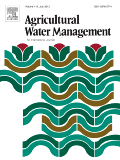
Agricultural Water Management
Scope & Guideline
Advancing Sustainable Solutions in Agricultural Water Management
Introduction
Aims and Scopes
- Irrigation Management and Optimization:
Research focusing on the optimization of irrigation practices, including the use of advanced technologies and decision-support systems to enhance water use efficiency in various crops. - Water Resource Sustainability:
Studies addressing sustainable management of water resources, including groundwater recharge, pollution control, and the impact of agricultural practices on water quality. - Climate Change Impacts and Adaptation:
Investigations into how climate change affects water availability and agricultural productivity, along with strategies for adapting to these changes. - Soil-Water Relationships:
Research exploring the interactions between soil properties and water management practices, including studies on soil moisture dynamics, salinity, and nutrient retention. - Agricultural Practices and Water Productivity:
Studies evaluating the effects of different agricultural practices, such as mulching, cover cropping, and crop rotation, on water productivity and overall farm sustainability. - Remote Sensing and Modeling Techniques:
The application of remote sensing technologies and modeling approaches to assess and monitor water use, evapotranspiration, and crop responses in agricultural systems. - Socioeconomic Aspects of Water Management:
Research that examines the socioeconomic impacts of water management policies and practices on agricultural productivity and rural communities.
Trending and Emerging
- Precision Irrigation Technologies:
An increasing number of studies are focusing on precision irrigation, utilizing technology such as sensors and automated systems to optimize water delivery and improve crop yields. - Climate Resilience Strategies:
Research into adaptive strategies for enhancing agricultural resilience to climate change is on the rise, focusing on practices that mitigate risks associated with water scarcity and extreme weather events. - Integrated Water-Food-Energy Nexus:
There is a growing trend towards studying the interconnections between water, food, and energy systems, emphasizing the need for integrated management approaches that consider the overall sustainability of these resources. - Remote Sensing and Data Analytics:
The use of remote sensing and big data analytics for monitoring and managing agricultural water use is increasingly prevalent, enabling more accurate assessments of water needs and efficiencies. - Sustainable Practices for Soil Health:
Emerging research focuses on sustainable agricultural practices that enhance soil health and water retention, such as the use of cover crops, conservation tillage, and organic amendments. - Water Quality Management:
There is an increasing emphasis on research related to water quality in agricultural systems, particularly concerning the impacts of irrigation practices on water pollution and ecosystem health.
Declining or Waning
- Traditional Irrigation Techniques:
There has been a noticeable decrease in publications focused solely on traditional irrigation methods, as more emphasis is placed on innovative technologies and precision irrigation practices. - Static Water Management Policies:
Research on static or non-adaptive water management policies has waned, with a shift towards dynamic, flexible approaches that consider real-time data and changing conditions. - Single-Crop Studies:
Studies focusing exclusively on single-crop systems have decreased, as there is a growing interest in multi-crop systems and integrated approaches to enhance overall water efficiency and productivity. - Historical Water Use Analysis:
Research that primarily examines historical water use trends without considering contemporary challenges and innovations has become less prevalent, as the focus shifts to forward-looking, adaptive strategies.
Similar Journals
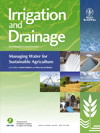
IRRIGATION AND DRAINAGE
Innovating irrigation practices for a resilient future.IRRIGATION AND DRAINAGE, published by Wiley, is a prestigious academic journal that focuses on the critical fields of agronomy, crop science, and soil science. With an ISSN of 1531-0353 and an E-ISSN of 1531-0361, this journal serves as an essential platform for disseminating innovative research and insights relevant to the management of irrigation systems and drainage in agricultural practices. Based in the United Kingdom, the journal has shown a significant impact in its field, boasting a 2023 ranking in the Q2 quartile for both Agronomy and Crop Science and Soil Science. It ranks #149 out of 406 in Agricultural and Biological Sciences for Agronomy and Crop Science, and #66 out of 159 in Soil Science, placing it within the 58th to 63rd percentiles. This journal not only aims to advance knowledge in the sustainable management of water resources and soil health but also encourages open access to its content, making significant findings more accessible to researchers, professionals, and students alike. As it approaches its convergence period from 2001 to 2024, the importance of IRRIGATION AND DRAINAGE in shaping effective agricultural strategies continues to grow, fostering dialogue and innovation among its readership.

Hydrology
Exploring the depths of hydrological knowledge.Hydrology, published by MDPI, is a prominent open-access journal dedicated to advancing the field of hydrological science. Since its establishment in 2014, the journal has garnered a reputation for excellence, reflected in its classification within the Q2 quartile for 2023 across multiple categories including Earth-Surface Processes, Oceanography, Water Science and Technology, and Waste Management and Disposal. Based in Switzerland, Hydrology provides a vital platform for scholars and practitioners to disseminate research findings, promote innovative methodologies, and foster discussions on current trends affecting water resources and management globally. The journal is easily accessible online and aims to significantly contribute to the understanding of hydrological processes, offering insights that are pivotal for addressing contemporary environmental challenges. With Scopus rankings showcasing its growing influence, Hydrology is a crucial resource for researchers, students, and professionals committed to water science and sustainable practices.
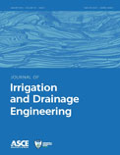
JOURNAL OF IRRIGATION AND DRAINAGE ENGINEERING
Elevating Standards in Irrigation and Drainage EngineeringJOURNAL OF IRRIGATION AND DRAINAGE ENGINEERING, published by the ASCE - American Society of Civil Engineers, stands as a pivotal resource in the fields of irrigation and drainage engineering. With a rich publication history dating back to 1966 and continuing robustly through to 2024, this journal serves as a critical platform for disseminating innovative research and developments that contribute to effective water management practices. Catering to an audience of researchers, professionals, and students, it holds a notable impact factor within its categories, ranking Q2 in Agricultural and Biological Sciences (miscellaneous) and Q3 in both Civil and Structural Engineering and Water Science and Technology for 2023. This journal not only stimulates dialogue among experts but also addresses pressing global water challenges, promoting sustainable practices in resource management. Although it does not offer open access, the depth of its content and adherence to rigorous academic standards ensure it remains an essential citation for anyone involved in water resource engineering and the applied sciences surrounding agricultural efficiency.
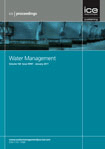
PROCEEDINGS OF THE INSTITUTION OF CIVIL ENGINEERS-WATER MANAGEMENT
Pioneering Research for a Sustainable Water FuturePROCEEDINGS OF THE INSTITUTION OF CIVIL ENGINEERS-WATER MANAGEMENT is a prestigious journal published by Emerald Group Publishing Ltd, dedicated to advancing the field of water management within civil engineering. With an ISSN of 1741-7589 and an E-ISSN of 1751-7729, this journal delivers peer-reviewed research that spans the critical intersections of water science and technology, contributing valuable insights into sustainable water management practices. As evidenced by its ranking in the 2023 Scopus categories, where it holds the Q3 quartile in Water Science and Technology, and a respectable position among its peers, the journal remains a vital resource for researchers, professionals, and students in the field. Though it is not an open-access journal, it offers accessible subscription options that facilitate worldwide dissemination of knowledge, enhancing its role as a fundamental reference point for cutting-edge developments in water management. For those looking to publish or stay updated on the latest research trends, this journal serves as an essential platform for promoting innovation and sustainable practices in civil engineering and water resources management.
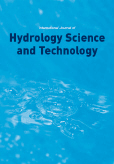
International Journal of Hydrology Science and Technology
Exploring Innovative Solutions in Water ScienceThe International Journal of Hydrology Science and Technology, published by InderScience Enterprises Ltd, is a distinguished platform dedicated to advancing knowledge in the field of hydrology, environmental engineering, and water science. With an ISSN of 2042-7808 and an E-ISSN of 2042-7816, this journal, established in 2011 and continuing through 2024, serves as an essential resource for researchers, professionals, and students alike. Despite being categorized in the Q3 quartile across multiple disciplines including Earth and Planetary Sciences, Environmental Engineering, Waste Management and Disposal, and Water Science and Technology, the journal maintains a reputation for contributing significant findings that impact both theory and practical applications in addressing hydrological challenges. Currently unavailable through Open Access options, the journal remains committed to disseminating valuable research that informs sustainable practices in water resource management. The editorial team encourages submissions that explore innovative strategies and methodologies while fostering interdisciplinary discussions, making this journal a pivotal player in shaping the future of hydrological science.
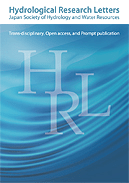
Hydrological Research Letters
Cutting-edge Discoveries: Transforming Hydrological UnderstandingHydrological Research Letters (ISSN: 1882-3416) is a distinguished peer-reviewed journal published by JSHWR, JAGH, JAHS, JSPH in Japan. Established with open access since 2007, this journal serves as a critical platform for the dissemination of innovative research in the field of hydrology, water science, and technology. With an increasing impact factor, currently positioned in the Q3 quartile for both Earth and Planetary Sciences and Water Science and Technology, it attracts a diverse readership keen to stay abreast of groundbreaking findings that shape water management and environmental policy. Researchers, professionals, and students alike will find this publication an invaluable resource for enhancing their understanding of hydrological processes and their implications. The journal is committed to fostering open academic dialogue and encouraging high-quality contributions during its converging years from 2015 to 2024. For more information, authors and readers can access the journal at its address, C/O INT ACAD PRINTING CO, LTD, Shinjuku-ku, Tokyo, Japan.
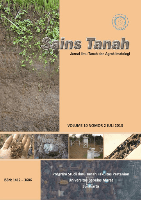
SAINS TANAH
Fostering Sustainable Practices in Soil and Crop ManagementSAINS TANAH is a renowned peer-reviewed journal that focuses on the fields of agronomy, soil science, and environmental studies, published by Universitas Sebelas Maret Surakarta in Indonesia. Established as an Open Access platform since 2001, it aims to disseminate high-quality research that addresses critical issues in soil health, crop management, and pollution, thereby fostering sustainable agricultural practices. With its current impact factor demonstrating a Category Quartile ranking of Q3 and Q4 in major areas such as Agronomy and Crop Science, Atmospheric Science, and Pollution, SAINS TANAH serves as an essential resource for researchers, professionals, and students dedicated to advancing knowledge and solutions in these vital fields. By providing a collaborative environment and upholding rigorous academic standards, the journal not only highlights the significance of Indonesian research contributions but also aims to connect local insights with global agricultural and environmental challenges.

International Journal of Agriculture and Natural Resources
Connecting Researchers for a Greener TomorrowInternational Journal of Agriculture and Natural Resources is a premier academic journal published by the Pontificia Universidad Católica de Chile, Facultad de Agronomía e Ingeniería Forestal. With an ISSN of 2452-5731 and an e-ISSN of the same, this journal operates as an Open Access publication, allowing for the widespread dissemination of research findings pertinent to the fields of agriculture and natural resources. As of 2023, it holds a commendable Q2 ranking in Agricultural and Biological Sciences, indicating its significant contribution to the field. The journal's objective is to provide a platform for innovative research and in-depth analyses on emerging trends and challenges within agriculture, promoting sustainability and ecological balance. Covering a broad spectrum of topics, it aims to foster dialogue among researchers, professionals, and students, ultimately enhancing knowledge and fostering collaboration. With a current Scopus rank of #93 out of 221 in the general agricultural and biological sciences category, it occupies a vital role in advancing research and practices in agriculture and related disciplines.

Transactions of the ASABE
Exploring the intersection of biology and engineering.Transactions of the ASABE is a premier journal published by the American Society of Agricultural and Biological Engineers, specializing in innovative research and practical applications in the fields of agricultural and biological engineering. With an ISSN of 2151-0032 and E-ISSN 2151-0040, this journal has established a vital niche in disseminating high-quality scholarly content that addresses the complex challenges faced in agriculture and biological systems. The journal operates under an open access model, facilitating broad dissemination of research findings to a global audience. This commitment to accessibility is reflected in its coverage of diverse topics, including agriculture, soil science, food science, and environmental engineering. Although the journal's coverage in Scopus was discontinued in 2021, it once ranked among the top in its categories, indicating its significant contribution to advancing knowledge in these essential fields. Researchers, practitioners, and students are encouraged to engage with the Transactions of the ASABE to stay abreast of developments and foster collaboration in promoting sustainable engineering solutions.

APPLIED ENGINEERING IN AGRICULTURE
Enhancing Productivity and Sustainability in Agriculture through Engineering Excellence.APPLIED ENGINEERING IN AGRICULTURE is a peer-reviewed journal published by the American Society of Agricultural and Biological Engineers, dedicated to advancing the field of agricultural engineering through the dissemination of high-quality research. With an ISSN of 0883-8542 and an e-ISSN of 1943-7838, this journal has been a key resource since its inception in 1985, serving as a vital platform for scholars and practitioners to share innovative ideas and practical solutions that enhance productivity and sustainability in agricultural practices. The journal is ranked in the Q3 category for Engineering (miscellaneous) as of 2023, and is positioned within the 43rd percentile of the general engineering rankings in Scopus. While not currently an open-access journal, APPLIED ENGINEERING IN AGRICULTURE remains crucial for researchers and professionals looking to explore diverse engineering solutions that address the complexities of modern agriculture, making it an invaluable resource for anyone committed to improving agricultural systems through engineering advancements.